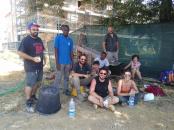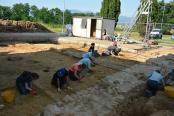CAMPAGNA 2016 |
1° SETTIMANA |
2° SETTIMANA |
3° SETTIMANA |
4° SETTIMANA |
5° SETTIMANA |
6° SETTIMANA |
29 GIUGNO 2016 
Resoconto della giornata di scavo
Generale
Oggi sono passati a trovarci sul sito due migranti del Gambia, in "pellegrinaggio" sulla Francigena accompagnati dal personale di un centro di accoglienza di Capannori. I due ragazzi subito si sono prodigati a scavare e a pulire le aree assieme a noi. Prima ancora che potessimo ringraziarli per l'aiuto, lo hanno fatto loro, senza chiederci niente, sempre col sorriso sulle labbra.Nella consapevolezza della tragedia umanitaria che sta colpendo tante parti del mondo, è comunque bello pensare che, nel suo piccolo, anche uno scavo archeologico riesca a ridurre le distanze, avvicinando tra di loro le persone. Ancora grazie!
Area 2000
Nell’allargamento ovest sono stati individuati due tagli sepolcrali appartenenti alla fase medievale coeva a quella già identificata nel Settore A. L’indagine si è focalizzata sul più recente (US-2701) del quale è stato parzialmente rimosso il riempimento (US 2700) così da permettere la parziale messa in luce dell’individuo ivi sepolto (Usk 2702), di cui ancora non è chiara la posizione; questa fossa intercetta la seconda, la quale si colloca più ad Ovest proseguendo al di sotto della sezione di scavo e che, per tale motivo, sarà probabilmente indagata dopo l’allargamento previsto nei prossimi giorni.
Nel Settore A è iniziata l’esposizione di due individui di epoca medievale deposti all’interno di due fosse orientate Ovest Est aventi un andamento leggermente obliquo, poste nella metà Occidentale. Usk 2714 è stato intercettato a livello delle diafisi dei femori da una delle fosse ottocentesche documentate durante gli scorsi anni, e risulta mal preservato. Dell’inumato Usk 2711, invece, si preservano il cranio, parzialmente le coste e le vertebre, gli arti superiori distesi e paralleli al corpo, il bacino e metà degli arti inferiori.
Today was a continuation for many members of the group. Max and Mark (Mark was later replaced by Lydia then Courtney) proceeded to excavate the osseous remains from the Northwest portion, but each specimen found was a long bone, and no other type. Kit and Morgan finished their area in the Northeast and determined that they had not found a grave. They then moved further to the Northeast corner of the West extension and began clearing the area, finding a medieval burial, likely in lateral recumbency. The remains were very fragile and friable. Shelby continued to work in the central Southeast area, clearing filling from a grave and she found among the human remains: glass, pottery, fauna and nails. We continued excavation of fill 2712 in order to reveal skeleton 2711, of which we uncovered most of the skull, humeri, and pelvis.
Area 3000
Nel corso della mattinata si è proceduto con la pulizia generale dell’area ed in particolare del Settore B, dove si concentreranno principalmente le indagini di questa campagna di scavo. Nella porzione settentrionale di tale settore sono state individuate e documentate alcune buche di forma irregolare (US -3691 e US – 3693), collocate rispettivamente a ridosso della canaletta di epoca moderna US -3220 ed in prossimità del perimetrale settentrionale USM 3073. Altre due buche (US – 3685 e US – 3687), di forma allungata e più regolare, sono state inoltre scavate nella porzione sud-occidentale del settore. A ridosso del perimetrale meridionale USM 5003, in corrispondenza dell’angolo occidentale, in corso lo scavo di una fossa sepolcrale piuttosto stretta, all’interno della quale stanno venendo alla luce alcune ossa in connessione anatomica. Più ad Est è stato messo in luce un individuo infantile orientato W-E e deposto supino in US – 3571. Di tale scheletro, mal preservato, si conserva solamente parte del cranio, molto frammentato, alcune coste, parte dell’avambraccio destro ed alcune ossa del bacino; gli arti inferiori sono stati intercettati ed asportati dal taglio di una buca di epoca successiva.
Wendesday we began excavating after splitting up into groups.
- The first group started excavating an area by the central north wall. The group began excavating a cut but stopped a little ways down when a bone fragment was found and it seemed that it was ontop of a possible cut grave site.
- Second group began excavations on a site that is in the southeast corner of the site which abuts the eastern wall. Excavated approximately 20 centimeters of fill to reveal a disarticulated left foot of a single individual. Further excavation revealed a right fibula and tibia of a second individual. This indicates the complexity of the site. To understand the relationship between the two individuals, the site was further expanded to the south.
- Third group started excavations on an area that was near the middle of the site in sector B. Cranial elements were observed prior to the begining of excavation today. After further excavation anatomically articulated skeletal elements of one sub-adult emerged. For the rest of the day we continued to expose the remains leading to a partial cranum, thorax, upper limbs and partial os coxa available in anatmoical position. Lower limb bones were not present. Coordinate points and photographs were taken. We covered the remains to protect them over night. We hope to remove the skeletal materials tomorrow.
- Fourth Group started with two possible infant graves. Students excavated the graves and one grave had minimal human bone fragments; the unit was classified a pit. Grave was cleaned, coordinate points were established, and photographed. One student departed to the Osteology Laboratory to clean the remains of one individual and a cranium from a second individual. Student who remained at the site proceeded to establish the border of one grave with visible human bones. Student at the site proceeded to complete the stratigraphy sheet of portions of the sector. After receiving an explanation of the protocols of filling out the stratigraphy sheet by the Supervisor, Student returned to excavating but was unable to complete the task until next day.
Area 5000
On this the third day of the field school, area 5000 completed one additional clean before excavation began. Afterwards, the crew divided, some members began excavating the contents of the features previously thought to be post holes and the remaining members prepared the pavement area in section A to be photographed and surveyed for GIS with a total station. The artifacts found in the holes included: a travertine stone of potential Roman origin, numerous pieces of unglazed red paste pottery, an animal long bone with signs of burning likely from a small to medium mammal. Two members of the crew were not involved in excavation because one was in the osteology lab and the other was in the GIS lab.
Nella giornata di oggi è stata effettuata una nuova pulizia dell'area per mettere definitivamente in luce le evidenze stratigrafiche già emerse ieri. Dopo aver completato la documentazione fotografica riguardante le quattro nuove buche nominate UUSS 5266, 5267,5268 e 5269, emerse nella porzione orientale dell'area di scavo, si è cominciato con la loro escavazione. Dai riempimenti emergono dei frammenti ceramici medievali privi di rivestimento e un frammento di travertino. Quest'ultimo, anche se piccolo, si aggiunge agli elementi di età romana già individuati nei pressi del sito di scavo nelle scorse stagioni.
Area 6000
È iniziata, nel settore A dell'area, la rimozione dello strato US 6001, a matrice argillosa ed altamente compatta, che copre l'intera superficie d'indagine. Lo strato in questione ha visto una profonda modificazione in età pre-contemporanea a causa della realizzazione del piazzale in asfalto attualmente presente nel sito; azione che ha prodotto un taglio orizzontale omogeneo su tutta l'area compromettendo le interfacce superiori degli strati presenti in quel momento. La rimozione di US 6001 permetterà di interfacciarsi direttamente con i contesti cimiteriali già rinvenuti nel settore B dell'area, omologo di A e separato da esso dalla trincea US -6007.
Throughout the morning, we finished pickaxing Section A and clean troweled the area of 6001. During this time, we discovered bones and rocks on the surface and defined their edges by troweling and brushing around them. Once this was completed, we stood at the edge of Section A to better understand context 6001. Our supervisor explained that this layer still contained both modern and comtemporary activity. Some of the bones were scattered, and there were remnants of the pavement still in tact. Our main interest is in the context below because it may be less disturbed and contain more archaeological information. So, we began to trowel the hard surface of 6001 until we reached a softer dark layer of soil underneath. We continued to find bones in situ, in addition to artifacts such as nails, glass, and pottery. Hopefully tomorrow we will complete clearing 6001 and collecting any bones and artifacts that we find. Then we may be able to find undisturbed features.













